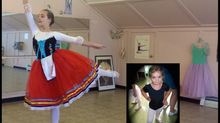Am I ready to take Pre-Pointe class?
- Miss Stephanie
- Aug 10, 2017
- 4 min read

Gliding across a stage, dancing in a fluffy tutu "en pointe" (what some refer to as "toe dancing") is what most people envision when they think of a ballerina. It's certainly what most little girls have in mind when they ask to go to their first ballet class.
You may be looking at a dance class schedule wondering what Pre-Pointe is, or maybe you already know and you really want to ask your teacher if you can register for it this year.
The three dancers in this image are wearing
different shoe styles. The boxes, widths, vamps
and shanks vary for their individual needs.
Pre-Pointe is a class your teacher invites you to take when s/he feels that you're ready. There are many things a teacher looks for, but here are a few that I look for:
The student...
• is at least 11 years old, so your bones have ossified (hardened) enough to withstand your body weight
• listens to and applies correction
• has consistently correct alignment and body placement
• understands their own body and can adjust as instructed
• has patience and is willing to focus on repetitive movements and learn
• has a strong will and doesn't easily give up
• respects the decisions I make for their own personal safety and comfort
• has shown a dedication to improving their dance skills in the past, not just now when they want to get pointe shoes
• has feet that can handle pointe - there are lots of different shapes and sizes of feet, toes, heels and arches
• has discussed pointe with their parent(s) and understands what the costs and commitment will be
• is not currently in the middle of a growth spurt
• is more concerned with their personal progress than keeping up with others in the class
• has a high tolerance for discomfort, at least initially (we'll talk more about this)

Pre-Pointe (PP) is often considered the next level as a dancer progresses. I prefer to think of it as an elective, just like modern or jazz. It's not for everyone. If you're not interested, that's okay! If you are, work hard so you're ready when you're old enough! If it's not recommended for you, talk to your teacher about why. There are so many choices in dance, make the ones that are right for you!
PP class involves a lot of really boring, really important repetition exercises. Dancers stand at the barre and repeat foot movements, exercises, positions and stretches over and over again. If you're looking for instant gratification (I'm going to do it now!), you're looking for the wrong class. It takes time.
We also talk in PP class. We talk about your type of foot, what you can anticipate if you get pointe shoes, how they will feel, adjustments you may have to make for your particular foot type and more. All of this is before you even get shoes!

Dancers in a PP class, especially those who have come up over the years together, may all be offered the opportunity to get their shoes at the same time, but that's not always the case.
Being enrolled in a PP class does not guarantee you'll get to go on pointe this year, but if you listen, follow and focus, there's a great chance you will! After all, if you weren't already working hard to prepare in your normal classes, you wouldn't be invited into a PP class, right?
When you are ready to get pointe shoes, I'll personally take you to a reputable dance store to make sure you get a great pair of pointe shoes that fit your foot size and shape well.
It takes time to choose the right pointe shoe maker, style and padding that is right for you. Not all dance stores are created equal. Having a wide variety of choices, patient, knowledgeable staff and a great pointe shoe fitting are key to having a positive, enjoyable first pointe experience! Ordering pointe shoes online is not even an option.
Finally, a word about pain. The big question is always, "will it hurt"? I promise you, it shouldn't hurt if you're doing it right. You should be comfortable. That doesn't mean your pointe shoes will feel like your fuzzy bunny slippers or even like your ballet slippers. They are hard. When you dance, there will be friction.
Some of becoming comfortable is trial and error. In time, you'll learn where you need cushioning in your shoes and what areas of your feet require more protection. As you become a better dancer on pointe, and practice more often, yes, you may get blisters. If you know how to take care of your feet from the beginning, some of that can be avoided.
Now that you know more, are you interested in taking a class in Pre-Pointe? What other questions do you have? Let's talk about it!
- Miss Stephanie
Another pointe blog post you may be interested in:
Pointe shoes are not all the same! You'll be accompanied to the dance store to make sure you're sized for shoes that are perfect for your feet!


You'll learn how to take take care of your feet so you'll be smiling before and after each pointe class! As you progress, you'll be able to dance and perform on pointe!



































Comments